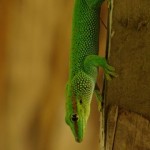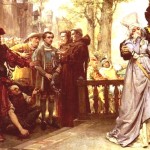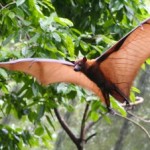Weekly Wrap Volume 55
 Why a Gecko’s Feet Can Stick to Almost Anything
Why a Gecko’s Feet Can Stick to Almost Anything
It has been observed since the 4th century BC that geckos have the ability to climb walls, hang upside down, and apparently “stick” to anything. Aristotle was the first known to have commented on the phenomenon, stating gecko’s have the ability to “run up and down a tree in any way, even with the head downwards.” It wasn’t until recently that it was discovered what gave them this spider-man-like ability. Gecko’s have millions of tiny… (more)
 Jus Primae Noctis: Fact or Fiction?
Jus Primae Noctis: Fact or Fiction?
The practice of jus primae noctis (“right of the first night”) is, in simplest terms, the right of the local noble to deflower local peasant brides on their wedding night before their newlywed husbands. Precedence for this practice supposedly goes back for many thousands of years, with the first reference of something like it going all the way back to the Epic of Gilgamesh from over four thousand years ago. This practiced (apparently) reached its crescendo during the Middle Ages in Europe, and today is popularly depicted in Hollywood in such films as Braveheart. But did it really ever happen?… (more)
 The High School Dropout Who Co-Created Trivial Pursuit
The High School Dropout Who Co-Created Trivial Pursuit
In December 1979, in the depths of a Montreal winter, two Canadian newspapermen created one of the most popular board games the world has ever known. High school dropout Chris Haney was the photo editor of The Gazette. He had originally dropped out of school at the age of 17 in order to take a copy boy job with the Canadian Press, the company his dad worked for. After his eventual Trivial Pursuit fame and riches, he would state he regretted his decision to drop out of school… at the age of 17; he stated he wished he’d done it at 12. (Incidentally, Dave Thomas, the founder of Wendy’s and the man partially responsible for saving KFC, was also a high school dropout.) In any event, Haney’s buddy, Scott Abbott, was the sports editor for The Canadian Press. According to legend, after realizing that… (more)
 The Truth About the Origin of Potato Chips
The Truth About the Origin of Potato Chips
The prevailing story of the origin of the potato chip starts in Saratoga Springs, New York, a historically affluent and resort community. It was 1853, eight years before the beginning of the Civil War. Known for its mineral springs and their supposed rejuvenation properties, Saratoga Springs had just started becoming a tourist destination with help of the railroad that cut through the town. Resorts, inns, restaurants, and spas had begun to crop up along the shores of Saratoga Lake. Moon’s Lake House, owned by Cary Moon, was one of the finest of those restaurants. Vacationers and wealthy summer home owners visited the restaurant often. At the restaurant, two people shared the cooking responsibilities, Catherine “Aunt Kate” Weeks and her brother (or brother-in-law, depending on who’s telling the story), George Crum… (more)
Big appetites can come in small packages. Case in point: 5′ 7″ and 125 pound Molly Schuyler, who lives with her husband and four kids (ages 5, 6, 7 and 10) in Bellevue, Nebraska. She maintains her lean frame by typically sticking to lots of vegetables, salads without dressing and keeping up with her four kids. She also notes, “We (competitive eaters) don’t eat like crazy all the time. That would just be impossible.” Working on her craft, what she has referred to as “a stupid human trick,” since she was a child, Molly noted that… (more)
Bonus Quick Facts:
- Before devoting himself more or less exclusively to music, Phil Collins was a child actor, appearing in various rolls, including playing The Artful Dodger in the London production of Oliver!; an extra in the Beatles’ A Hard Day’s Night; one of the extras in Chitty Chitty Bang Bang; and various other minor roles.
- In the early days of the World Wide Web, one of the most popular alternatives to the Web (and indeed more popular for a time), Gopher, looked like it was destined to dominate the Internet. Then the University of Minnesota announced in 1993 that they would no longer let people use their Gopher server implementation for free. Instead, licensing fees would be charged. This, combined with people being concerned that licensing fees for custom server implementations would also begin being levied, effectively killed the once rapid spread of Gopher, with the World Wide Web then quickly dominating the Internet. There are still Gopher servers online today (160), which is actually up from five years ago when there were only 100. In its heyday, the Gopher protocol was noted for being much faster and more efficient than the World Wide Web. It was also much easier to setup a Gopher server and it used less system resources than Web servers. It was, and is, also relatively easy to make Gopher clients or to add Gopher support to clients (even to modern browsers). No wonder it was more popular.
- The term “biscuit” derives from the Latin “bis coctus”, meaning “twice baked”, which is essentially what many types of biscuits are. The term first showed up in English around the 14th century. In America, the term biscuit now pretty much only means a small, quick rising, soft bread product. In most of the rest of the English speaking world, biscuit still refers to such things as hardtack, small cakes, cookies, etc.
- Nabisco originally released the saltine cracker in 1876. Their slogan for this new type of cracker was “Polly wants a cracker?”, which is where that saying came from. Saltine crackers were mildly successful after being released, but received a huge boost in popularity thanks to the Great Depression. Saltines were a cheap, tasty filler to add to other foods such as watery soup, to make the meal more filling.
- Sirius-A is the brightest extrasolar star visible to the naked eye from Earth, being almost twice as bright as the second brightest, Canopus. Sirius-A and Sirius-B combine to form a binary system and appear as one star to the naked eye. The vast majority of luminosity to the naked eye comes from Sirius-A, Sirius-B being a white dwarf which is only around 30 AU (astronomical units) away from Sirius-A. It is also theorized that there is a Sirius-C, but to date, this has not been proven. Sirius A and B (and possibly C) combine to form a bright point known as Sirius or the “Dog Star”. *looks at J.K. Rowling*
- Sirius-A is a white main sequence star (A1V) that is about twice the size of our Sun. The extreme brightness from our point of view comes not so much because it is a particularly bright star, but rather because it is only 8.6 light years away (2.6 parsecs). That’s a really long ways away by standards of distance we normally deal with (about 51 trillion miles or 83 trillion kilometers away); but by galactic standards, it’s just next door and is one of our nearest neighbors.
- Pablo Picasso’s full name was Pablo Diego José Francisco de Paula Juan Nepomuceno María de los Remedios Cipriano de la Santísima Trinidad Ruiz y Picasso.
- Camels have three eyelids. Two of the eyelids have eye lashes which help protect their eyes from sand. The third is a very thin lid which works as a sort of “windshield wiper” to clean off their eyes. It closes/opens from side to side rather than up and down. It is also thin enough that the Camels can see through it somewhat. So in a sandstorm or otherwise windy day where sand is being stirred up, they can close that lid to protect their eyes from the sand, but still see where they are going.
Other Interesting Stuff:
 How Long You Could Survive in Space Without a Space Suit
How Long You Could Survive in Space Without a Space Suit
If you ever find yourself exposed to the near vacuum of space, so long as you don’t try to hold your breath, which would result in your lungs rupturing and thus pretty well guaranteed that the incident would be fatal, you’ll likely remain conscious for about 10-15 seconds, with perhaps half that being useful consciousness. After that, you’ll be fine as long as you’re placed back in a pressurized environment within about 90-180 seconds. These numbers are based on both human accidents that have occurred and on experiments run on animals. For instance, in 1965, researchers at the Brooks Air Force Base in Texas ran a series of experiments… (more)
 Why New York City is Called “The Big Apple”
Why New York City is Called “The Big Apple”
The earliest documented reference to New York being referred to as “The Big Apple” comes from a 1909 book by Edward Martin, called The Wayfarer. In it, he uses the moniker in a metaphorical sense, rather than a proper name for the city: “Kansas is apt to see in New York a greedy city… It inclines to think that the big apple gets a disproportionate share of the national sap…” The next known documented instance of New York being called “The Big Apple” comes from sportswriter John J. Fitz Gerald who began popularizing the name starting on May 3, 1921… (more)
 Why Leaves Change Color in the Fall
Why Leaves Change Color in the Fall
The primary thing that triggers the changing of colors in leaves is the length of day. However, moisture and temperature play a role as well. For instance, an extreme drought in the summer can delay somewhat the changing of the colors in fall. Why this is the case is not wholly understood, but it is possibly from the tree not being able to make as much food to store up for the winter, in the case of the drought, so it might be trying to push the envelope a little in terms of making food for a couple more weeks before needing to shed the leaves. Temperature also plays a part in the ultimate vividness of the color. However, as far as the timing goes, seems to play… (more)
 Do Bats Get Confused by Other Bats’ Sonar?
Do Bats Get Confused by Other Bats’ Sonar?
Seeing with sound, bats can find their way around by bouncing sound waves off of objects. Called echolocation, it allows a bat to navigate the world with impressive accuracy and speed. However, each bat, even within a swarm, needs to emit its individual calls in order to navigate in certain conditions. (Note: contrary to popular belief, bats are not blind). As you can imagine, that’s a lot of sound waves bouncing around, and there is bound to be some overlap. Yet, despite the potential for interference, bats rarely are confused by their comrades’ calls. So why not?… (more)
A common origin story of pretzels is that they were created by a monk around 610 in Italy. According to The History of Science and Technology, the monk baked strips of dough that he folded into a shape resembling a child crossing its arms in prayer. He would give these treats, which he called “pretiolas” or “little rewards,” to children who had memorized their prayers. Unfortunately- and not surprisingly- there’s no documented evidence from the 600s to confirm this story. Other similar stories star a monk from France and bakers held hostage in Germany. While any one of these stories might have some modicum of merit, what we do know for certain is that the earliest recorded evidence of pretzels appeared in the crest of German bakers’ guilds in 1111. Later… (more)
This Week’s Podcast Episodes:
- Podcast Episode #225: The Food Pyramid and Why You Shouldn’t Follow It
- Podcast Episode #226: The Remarkable Audie Murphy
- Podcast Episode #227: Justin Verlander and a Chocolate Milk
- Podcast Episode #228: ACME
- Podcast Episode #229: The Colosseum’s Much Bigger Brother, The Circus Maximus
Quote of the Week:
- “Knowledge is power. Information is liberating. Education is the premise of progress, in every society, in every family.” -Kofi Annan
| Share the Knowledge! |
|






